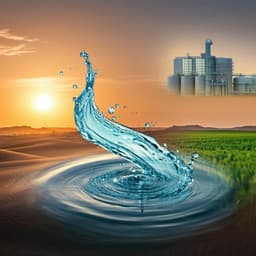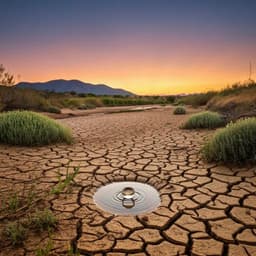
Agriculture
Efficient agricultural practices in Africa reduce crop water footprint despite climate change, but rely on blue water resources
V. Giordano, M. Tuninetti, et al.
Explore the vital connection between water management and food production in Africa as researchers Vittorio Giordano, Marta Tuninetti, and Francesco Laio uncover the implications of climate change for crop yields and water resources. Their compelling study reveals crucial strategies to sustain agricultural growth amidst pressing environmental challenges.
~3 min • Beginner • English
Introduction
The study addresses how climate change, coupled with rising food demand, will affect African agriculture’s water use and yields, and whether agricultural intensification can reduce crop water footprint while supporting food security. The context includes warming temperatures, altered precipitation, increased atmospheric CO2, and projected yield declines at low latitudes. With Africa facing high malnutrition, water scarcity, and poverty, enhancing yields through improved practices is widely advocated, yet the water resource implications and climate constraints remain unclear. The purpose is to develop spatially explicit scenarios of crop water footprint (CWF) under RCP2.6 and RCP6.0 for 2040, 2070, and 2100, integrating high-input agricultural management and irrigation expansion, to quantify impacts on green and blue water demand and assess implications for food security.
Literature Review
Prior work shows climate change already affects global food production and will increasingly constrain yields, especially in low-latitude regions. Studies propose strategies such as sustainable intensification to meet demand and mitigate climate change but note substantial inputs of water and fertilizers are required. Global and national/basin-scale CWF studies exist, with some future scenarios and process-based projections; however, few compute high-resolution, sub-national CWF scenarios. Research also highlights irrigation water availability constraints, yield gaps, and the role of virtual water trade. This study advances the literature by providing 5-arc-minute, Africa-wide, crop-specific CWF scenarios that integrate emissions pathways with agricultural management and irrigation expansion, quantifying trade-offs between water use intensity reductions and increased blue water requirements.
Methodology
Study scope: Twelve major African crops (barley, cassava, cotton, groundnut, maize, millet, rice, sorghum, soybean, sugarcane, wheat, yam) representing ~61% of production and ~62% of harvested area. Baseline year: 2010; future horizons: 2040, 2070, 2100; scenarios under RCP2.6 and RCP6.0.
Climate data: Historical observations for precipitation (CRU CL v2.0; 10×10 arc min) and reference evapotranspiration ET0 (FAO Penman–Monteith; 5×5 arc min) for 1961–1990. Historical and future projections (2011–2100) of monthly P and ET0 from ISI-MIP2b (30×30 arc min) driven by GFDL-ESM2M, HadGEM2-ES, IPSL-CM5A-LR, MIROC5 (ET0 via PCR-GLOBWB). Data downscaled to 5×5 arc min. Climate ‘anchoring’: anomalies between present/future intervals and 1961–1990 ISI-MIP simulations were added to observed 1961–1990 references to reduce model bias.
Agricultural data and management: Crop-specific attainable (future) and actual (2010) yields and harvested areas from GAEZ v4 at 5 arc min. Attainable yields assume high-input, market-oriented, mechanized agriculture with optimal irrigation, improved varieties, nutrient and pest/disease/weed management. Harvested areas fixed at 2010 extent to represent intensification. Weight conversions applied (fresh-to-dry, sugarcane sugar weight, cotton lint) per GAEZ documentation. Planting/harvest dates and growing periods from MIRCA2000, spatially interpolated to match GAEZ harvested areas. Crop coefficients, soil properties, available water content, root depth, depletion fraction from prior literature.
WaterCROP model: Spatially explicit daily crop water use model at 5×5 arc min, updated to produce monthly outputs and future scenarios. Daily actual ET (ETaj) computed using FAO56 approach: ETaj = kj·kcj·ET0j, where kj is daily water stress coefficient, kcj the crop coefficient, and ET0j daily reference ET. For rainfed systems kj varies with soil water balance (TAWC, RAWC, rooting depth); for irrigated systems kj=1 (no water stress). Annual crop ETa obtained by summing daily ETaj over the growing season. Green (precipitation-derived) and blue (irrigation) components computed for both rainfed and irrigated production, including effective precipitation.
CWF metrics: Total WF (m³) and unitary WF (uWF; m³ ton−1) disaggregated into green (uWFg), blue (uWFb), rainfed (uWFrf), and irrigated (uWFirr) components:
- uWFrf = 10·ETRrf / Yrf
- uWFirr = 10·(ETgr + ETb) / Yirr
- uWFg = 10·(ETgr + ETb) / Ytot
- uWFb = 10·ETb / Ytot
Scenario design:
- Hard-intensification pathway (SSP5-consistent): from 2040, all currently rainfed areas assumed irrigated optimally to achieve GAEZ attainable yields; harvested area fixed at 2010. Additional blue water on rainfed areas computed as ETp − ETa (potential vs. current ET) to close yield gaps.
- Extensification pathway (SSP2-consistent): harvested areas extrapolated to 2040 using FAOSTAT 2000–2020 trends; yields adjusted so total production matches that of intensification; used for continent-aggregated WF and uWF comparisons.
Temporal aggregation: 30-year averages for 1981–2005 (to represent 2010 baseline), 2011–2040, 2041–2070, 2071–2100, averaging across available GCMs.
Food security indicators: Average water stress coefficient ks (0–1) computed as mean daily kj over the rainfed growing season, aggregated across crops; caloric yield (kcal ha−1) derived from yields using USDA FoodData Central conversion factors, weighted over harvested areas (staple crops only). Compared against FAOSTAT prevalence of moderate/severe food insecurity (2019).
Uncertainty: Recognized sources include uWF model error (~9–13% for major crops), sensitivity to planting dates, growing period length, soil water parameters, ET0 estimation method (Penman–Monteith vs alternatives), and large uncertainty in yield projections (socioeconomic dependencies).
Key Findings
- Baseline spatial patterns (2010): Highest green WF concentrated along the Sahel; Nigeria shows the largest green WF (1.22×10^11 m³). Blue WF concentrated along the Nile and in South Africa; Egypt has the highest blue WF (1.76×10^10 m³).
- Climate change signature on green WF: Under RCP6.0 by 2040, equatorial and Gulf of Guinea regions show positive green WF changes (e.g., Equatorial Guinea +7.14% average), driven by higher temperature and ET where soil moisture suffices; North Africa and the Horn of Africa show negative green WF changes indicating drying and increased water stress. Trends intensify in 2070 and 2100.
- Blue water expansion under intensification: Assuming irrigation is extended to all rainfed areas by 2040, additional blue WF required is ~82.9 km³ (RCP6.0), with Tanzania contributing ~12.5 km³; total African blue WF grows further, reaching ~135.5 km³ by 2100. Additional irrigation needs are greatest where ETp−ETr gaps are largest (Sahel, North Africa).
- Unitary water footprint (uWF) changes by 2040: High-input intensification yields steep reductions in green uWF for all crops; blue shares rise to support yield increases. Sorghum shows the largest green uWF reduction (~83.1% by 2040, RCP6.0). Cotton has the highest green water requirement in 2010 (~1.13×10^4 m³ ton−1) and the largest increase in blue uWF by 2040 (~3.7×10^3 m³ ton−1). After 2040, with management fixed, climate effects dominate: many crops’ uWF increases and the gap between RCP2.6 and RCP6.0 widens.
- Staple vs cash crops: Cash crops (cotton, sugarcane) consume the highest irrigation water in all scenarios; intensification reduces water use intensity substantially for staple crops (up to 64% by 2040) but only marginally for cash crops (~5%). Staple crop blue uWF shares remain much lower, reflecting widespread lack of irrigation infrastructure and dependence on green water.
- Soil moisture and food security: ks declines in many North African countries (more arid conditions) though these countries have below-average prevalence of food insecurity due to imports. Several highly food-insecure countries (e.g., Congo, Somalia, South Sudan, Sierra Leone, Malawi) show below-average ks, indicating compounding vulnerability.
- Caloric yield changes: 2010 caloric yields are low (e.g., Sudan ~7.8×10^5 kcal ha−1). Under intensification by 2040, large caloric yield increases occur, especially in Sahel, Central and East Africa; Lesotho and Zimbabwe exhibit ~1000% increases, signaling large yield gap closure potential.
- Intensification vs extensification: Extensification (area expansion) requires larger water volumes and often worsens uWF (e.g., cassava, rice, soy) compared to intensification which improves water use intensity. For wheat and millet, differences between pathways are small; millet and sorghum show strong uWF reductions under both pathways due to assumed yield increases.
- Coverage: The 12 crops account for ~60.6% of production (kcal cap−1 day−1) and ~61.7% of harvested area (2019).
Discussion
Findings indicate that high-input intensification coupled with irrigation expansion can markedly reduce water use intensity for staple crops and boost caloric yields, potentially enhancing food security under climate change. However, such gains are contingent on substantial additional blue water withdrawals and expanded irrigation infrastructure, with largest demands in semi-arid and Sahelian zones where ETp−ETr gaps are widest. Climate change will alter precipitation, evapotranspiration, and soil moisture, increasing water stress in parts of North and Horn of Africa, which may counteract some efficiency gains post-2040 and widen scenario differences (RCP6.0 vs RCP2.6). The dominance of irrigation demand by cash crops raises equity and food security considerations since these do not directly contribute calories domestically. Compared with extensification, intensification better moderates water use per unit production and limits land conversion, but it implies environmental (agrochemical pollution, biodiversity impacts, reduced agroecosystem redundancy) and social trade-offs (possible shifts from smallholders to large-scale agriculture). Policy implications include prioritizing sustainable irrigation expansion, efficient water management, and tailored, region-specific strategies that integrate food security with environmental and socio-economic objectives.
Conclusion
The study provides high-resolution, Africa-wide scenarios of crop water footprint under climate change, coupling emissions pathways with agricultural intensification and irrigation expansion. Results show that intensification can reduce water use intensity substantially for staple crops and close yield gaps to improve caloric production, but at the cost of increased blue water requirements (≈83 km³ by 2040 up to ≈135 km³ by 2100) and potential environmental and social impacts. The scenarios help identify hotspots where crops face high climate impacts and where trade-offs between management intensity and irrigation demand are acute, informing policymakers and stakeholders. Future research should incorporate updated climate-impact simulations (ISI-MIP round 3), integrate SSP–RCP combined scenarios, quantify energy needs for increased water withdrawals, explore sub-national land expansion and crop substitution strategies to optimize production while limiting water and energy demand, and assess the role of intra-African trade (e.g., AfCFTA) in meeting future food needs.
Limitations
Key limitations include: reliance on ISI-MIP2b and GAEZ v4 datasets with baseline years (2006/2010) and no integrated SSP–RCP combinations; substantial uncertainty in yield projections driven by socioeconomic assumptions; model assumptions of full attainable yield realization by 2040 and optimal irrigation extended to all current rainfed areas; fixed harvested area for the intensification pathway; and acknowledged uWF estimation errors (~9–13% for major crops). Post-2040 projections reflect climate model uncertainties, and cash/staple crop treatment does not capture full economic/trade dynamics. The framework does not quantify energy requirements for additional water withdrawals.
Related Publications
Explore these studies to deepen your understanding of the subject.







